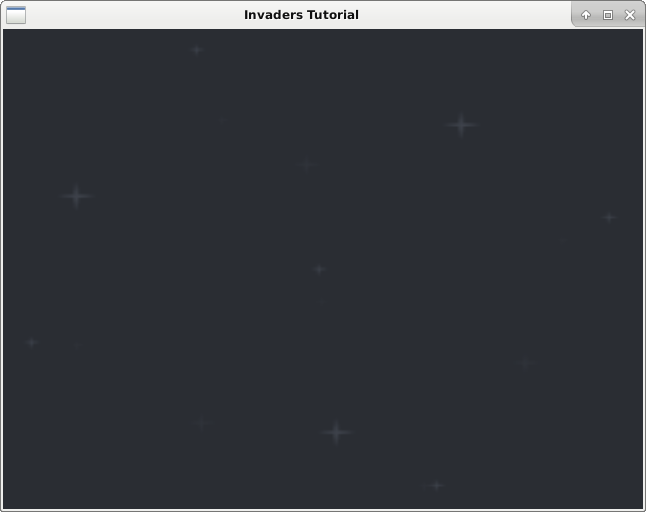Background Sprite
Gtk Invaders
Published
Liked the article? Share it!

Now that we’ve confirmed our coordinates cover our window, the next step is to load the background sprite and display it. We will use the Dash Graphics Libary to load the png files for us, but we will need to change our shaders to use the uv coordinates we supply.
main.c
#include <epoxy/gl.h>
#include <epoxy/glx.h>
#include <gtk/gtk.h>
#include "DashGL/dashgl.h"
static void on_realize(GtkGLArea *area);
static void on_render(GtkGLArea *area, GdkGLContext *context);
#define WIDTH 640.0f
#define HEIGHT 480.0f
GLuint program;
GLuint vao, vbo_triangle, texture_id;
GLint attribute_texcoord, attribute_coord2d;
GLint uniform_mytexture;
int main(int argc, char *argv[]) {
GtkWidget *window;
GtkWidget *glArea;
gtk_init(&argc, &argv);
// Initialize Window
window = gtk_window_new(GTK_WINDOW_TOPLEVEL);
gtk_window_set_title(GTK_WINDOW(window), "Invaders Tutorial");
gtk_window_set_position(GTK_WINDOW(window), GTK_WIN_POS_CENTER);
gtk_window_set_default_size(GTK_WINDOW(window), 640, 480);
gtk_window_set_type_hint(GTK_WINDOW(window), GDK_WINDOW_TYPE_HINT_UTILITY);
g_signal_connect(window, "destroy", G_CALLBACK(gtk_main_quit), NULL);
// Initialize GTK GL Area
glArea = gtk_gl_area_new();
gtk_widget_set_vexpand(glArea, TRUE);
gtk_widget_set_hexpand(glArea, TRUE);
g_signal_connect(glArea, "realize", G_CALLBACK(on_realize), NULL);
g_signal_connect(glArea, "render", G_CALLBACK(on_render), NULL);
gtk_container_add(GTK_CONTAINER(window), glArea);
// Show widgets
gtk_widget_show_all(window);
gtk_main();
return 0;
}
static void on_realize(GtkGLArea *area) {
// Debug Message
gtk_gl_area_make_current(area);
if(gtk_gl_area_get_error(area) != NULL) {
fprintf(stderr, "Unknown error
");
return;
}
const GLubyte *renderer = glGetString(GL_RENDER);
const GLubyte *version = glGetString(GL_VERSION);
g_print("Renderer: %s
", renderer);
g_print("OpenGL version supported %s
", version);
glClearColor(1.0f, 1.0f, 1.0f, 1.0f);
glGenVertexArrays(1, &vao);
glBindVertexArray(vao);
g_print("Triangle verticles
");
GLfloat triangle_vertices[] = {
0.0, 0.0, 0.0, 0.0,
0.0, HEIGHT, 0.0, 1.0,
WIDTH, HEIGHT, 1.0, 1.0,
0.0, 0.0, 0.0, 0.0,
WIDTH, HEIGHT, 1.0, 1.0,
WIDTH, 0.0, 1.0, 0.0
};
glGenBuffers(1, &vbo_triangle);
glBindBuffer(GL_ARRAY_BUFFER, vbo_triangle);
glBufferData(
GL_ARRAY_BUFFER,
sizeof(triangle_vertices),
triangle_vertices,
GL_STATIC_DRAW
);
GLint compile_ok = GL_FALSE;
GLint link_ok = GL_FALSE;
const char *vs = "shader/vertex.glsl";
const char *fs = "shader/fragment.glsl";
program = shader_load_program(vs, fs);
g_print("Loading texture file:
");
texture_id = shader_load_texture("sprites/background.png");
g_print("End loading texture
");
const char *attribute_name = "coord2d";
attribute_coord2d = glGetAttribLocation(program, attribute_name);
if(attribute_coord2d == -1) {
fprintf(stderr, "Could not bind attribute %s
", attribute_name);
return;
}
attribute_name = "uv_coord";
attribute_texcoord = glGetAttribLocation(program, attribute_name);
if(attribute_texcoord == -1) {
fprintf(stderr, "Could not bind attribute %s
", attribute_name);
return;
}
const char *uniform_name = "orthograph";
GLint uniform_ortho = glGetUniformLocation(program, uniform_name);
if(uniform_ortho == -1) {
fprintf(stderr, "Could not bind uniform %s
", uniform_name);
return;
}
uniform_name = "mytexture";
uniform_mytexture = glGetUniformLocation(program, uniform_name);
if(uniform_mytexture == -1) {
fprintf(stderr, "Could not bind uniform %s
", uniform_name);
return;
}
glUseProgram(program);
mat4 orthograph;
mat4_orthagonal(WIDTH, HEIGHT, orthograph);
glUniformMatrix4fv(uniform_ortho, 1, GL_FALSE, orthograph);
}
static void on_render(GtkGLArea *area, GdkGLContext *context) {
g_print("on render
");
glClear(GL_COLOR_BUFFER_BIT | GL_DEPTH_BUFFER_BIT);
glUseProgram(program);
glActiveTexture(GL_TEXTURE0);
glBindTexture(GL_TEXTURE_2D, texture_id);
glUniform1i(uniform_mytexture, 0);
glBindVertexArray(vao);
glEnableVertexAttribArray(attribute_coord2d);
glEnableVertexAttribArray(attribute_texcoord);
glBindBuffer(GL_ARRAY_BUFFER, vbo_triangle);
glVertexAttribPointer(
attribute_coord2d,
2,
GL_FLOAT,
GL_FALSE,
sizeof(float) * 4,
0
);
glVertexAttribPointer(
attribute_texcoord,
2,
GL_FLOAT,
GL_FALSE,
sizeof(float) * 4,
(void*)(sizeof(float) * 2)
);
glDrawArrays(GL_TRIANGLES, 0, 6);
glDisableVertexAttribArray(attribute_coord2d);
glDisableVertexAttribArray(attribute_texcoord);
}
Vertex Shader
Next we change our shader to accept uv coordinates.
shader/vertex.glsl
#version 120
uniform mat4 orthograph;
attribute vec2 coord2d;
attribute vec2 uv_coord;
varying vec2 texcoord;
void main (void) {
gl_Position = orthograph * vec4(coord2d, 0.0, 1.0);
texcoord = uv_coord;
}
Fragment Shader
Next we draw the texture in the fragement shader.
shader/fragment.glsl
#version 120
varying vec2 texcoord;
uniform sampler2D mytexture;
void main(void) {
vec2 flipped_texcoord = vec2(texcoord.x, 1.0 - texcoord.y);
gl_FragColor = texture2D(mytexture, flipped_texcoord);
}
Compile
$ gcc -c -o DashGL/dashgl.o DashGL/dashgl.c -lepoxy -lpng -lm
$ gcc `pkg-config --cflags gtk+-3.0` main.c DashGL/dashgl.o `pkg-config --libs gtk+-3.0` \
-lepoxy -lm -lpngRun
$ ./a.out